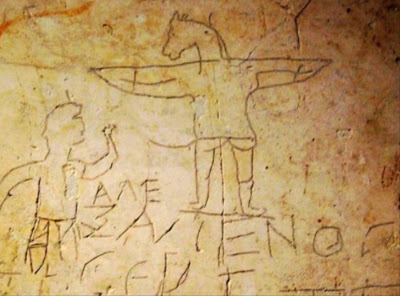A Liturgical Drama with an Earthy Jesus
The television-style series The Chosen presents an “earthy” Jesus, portrayed with warmth and humor, akin to liturgical drama—a form that, interestingly, aligns with how the early Qur’anic texts were drama plays, yet later revised according to the Hadith transmission but with the coopting of the Abassids.
Now in its fourth season, the series has sparked ecumenical controversy, particularly surrounding Jonathan Roumie’s portrayal of Jesus, which reflects his Catholic-Orthodox background. His visit to the Pope alongside creator Dallas Jenkins further fueled debate, especially with revelations about Mormon producers’ involvement in the series.
Still, the series resonates with a broad audience, as the public gravitates toward its dramatic storytelling and unifying elements. Perhaps its greatest success will be deepening biblical literacy—stirring the heart while prompting viewers to return to the New Testament text and live by its transformative message.

👉 Read: Jesus the Pharisee
A New Look at the Jewishness of Jesus
👉 Buy on Amazon
👉 YouTube: Obey the Pharisees
👉 The Anti-Christ
The above comparision is NOT quite right, showing that post WWII Messianic Jewish and Hebrew Rooters are not the Qehela and should not be considered as an authority on Jewish Halakah (Law). Caution is required by the Christian use of the term Notzrim in modern Hebrew. Such a direction helps uncover early formative groups indentified in the historical Jesus pursuit some of which are properly analyzed by the following. NOT THIS (1) BUT THIS (2)

One novelty of the series — among the other productions of the life of Jesus of Nazareth, which depict him more celestial — is his engagement between two historically verifiable schools of Pharisees, which the Rabbi consultant does affirm—known as Shammai and Hillel, which play out within the series and the drama. The latter aligned with Jesus’ teachings. The former was in control of the Sanhedrin and nationalists. The Sadducees inspired such nationalism through its political wing in a coalition with King Herod and by a terror wing of extremist assassin Zealots. Jesus recruited from these nationalists to renounce their evil ways; here, this ‘earthy’ Jesus’ pacifism finds traction in a realistic presentation that confronts the hyper—grace & faith only caricature of the proclamation of His gospel with His Jewish observance.
Thus, amid the many strong words Jesus used against certain Pharisees, probably Shammaites, he most importantly told His followers to obey them (Matthew 23:1- 3), “Do what they say for they sit in the seat of Moses.” Still, conflations of legalists with hypocrite Pharisees permeate our understanding. So, going against those with authority in the Qehela (the governing assembly within the synagogue) is a valid question, especially if Jesus was one of the Hillites or at least received by them. What gave him the authority to call out the clergy and highlight a religion, not an ethnic group framed as a nation? Along political lines, it seems that Jesus of Nazareth had no interest in overthrowing Rome. His mission was religious or spiritual.
Moreover, he proclaimed religion as a spiritual action. When Jesus stated: “Don’t do what they do,” he affirmed the Qehal following Jew over the Shammuti school or show-off Scribes and Pharisees, including opportunistic sola scriptura bound Sadducees who had no desire for Oral Torah observance. After all, who was the Apostle Paul but a Hillite taught by Gamaliel, who indeed echoed the position of our Lord against the ruling Sadducees and Shammaites, perhaps in a time of political and nationalistic manipulation? Again, these groups received His harshest words. They all went against Jesus of Nazareth and his inspiration toward the mission to the lost sheep of Israel, which came in many varieties due to the diversity of such an ethnic outreach and the grafting in (i.e., Idumea or Edom) and eventually the Gentiles or nations near and afar a process that has happened since Abraham’s Hagar (The Ger).
Shammaites and Sadducees most likely define the majority opinion of the Jew or Judean ethnocentric nationalists, mentioned in The Gospel of John, who stood against the old faith through political alignments and religious alliances, for their kingdom was the total of this world with or without Rome and where the Idumeans eventually transferred their alignment with power. Christian and ethnic Jewish nationalism is no novelty, and religious conscience is something utterly other than genuinely spiritual.
Therefore, the impulse of the Great Commission, salvation for all peoples, was also nothing new; it was just ‘Great’ in scope, inspired and aided by Hillite Pharisees onward toward Paul in The Book of Acts.
Jesus and Paul were not that different, contrary to popular opinion. They demonstrate that the New Testament, as a text of the Oral Torah, was recorded to create Hebrew believers and to be authoritative in doctrine. The context of the gospel points toward living as the righteous in the security of God’s purposes over earthly aspirations.
👉 Read: Jesus the Pharisee
A New Look at the Jewishness of Jesus
👉 Buy on Amazon
👉 YouTube: Obey the Pharisees
👉 The Anti-Christ
The above comparision is NOT quite right, showing that post WWII Messianic Jewish and Hebrew Rooters are not the Qehela and should not be considered as an authority on Jewish Halakah (Law). Caution is required by the Christian use of the term Notzrim in modern Hebrew. Such a direction helps uncover early formative groups indentified in the historical Jesus pursuit some of which are properly analyzed by the following. NOT THIS (1) BUT THIS (2)






